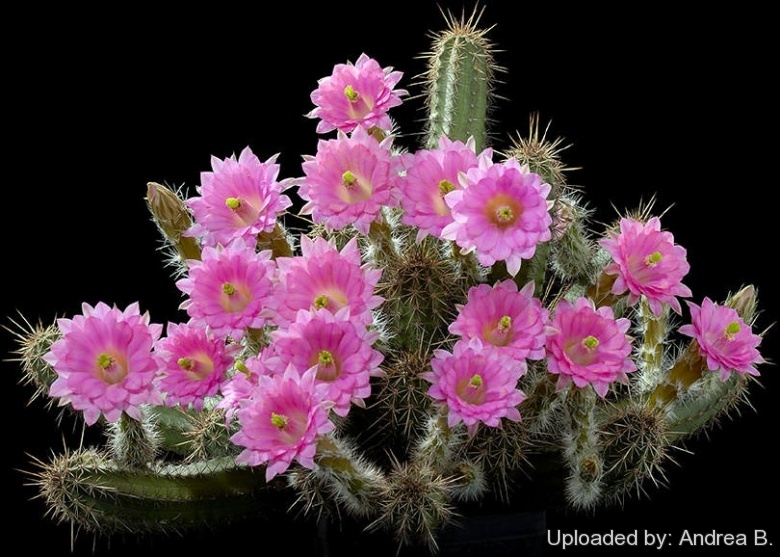
Echinocereus scheeri Photo by: Andrea B.
Origin and Habitat: South east Sonora ( Sierra de Alamos, San Antonio, Arroyo Gochico, Rio Cuchujaqui, upper Rio Cuchujaqui, E of Maicoba), Chihuahua ( Sierra Charuco) and West durango.
Altitude: 350-1800 metres above sea level.
Habitat: It grows hanging from cliffs, rocky slopes and shaded canyons on moss-covered ledges and boulders in xerophytic shrubland. In the same area it is possible to find several cactus species like: Mammillaria gueldemannianaSN|32873]]SN|8836]], Mammillaria sonorensisSN|9290]]SN|15981]], Mammillaria marksianaSN|20792]]SN|20792]], Mammillaria berkianaSN|15981]]SN|9290]], Mammillaria hertrichianaSN|8836]]SN|32873]], and Echinocereus subinermisSN|8657]]SN|16544]] v. luteus.
Ecologyt: Echinocereus scheeriSN|16544]]SN|8657]] has long, sturdy, orange-red flowers that appear to be adapted for humming-bird pollination. Abundant nectar is provided, as is characteristic of hummingbird flowers, while the absence of a detectable fragrance tends to rule out nocturnal pollination by long-tongued insects such as hawkmoths.
Synonyms:
See all synonyms of Echinocereus scheeri
back
Accepted name in llifle Database:Echinocereus scheeri (Salm-Dyck) ScheerBot. Voy. Herald [Seemann] 7-8: 291. 1856Synonymy: 13
Accepted name in llifle Database:Echinocereus scheeri subs. gentryi (Clover) N.P.TaylorCactaceae Consensus Init. 3: 9. 1997Synonymy: 3
Cultivars
(2):
back
Common Names include:
SPANISH (Español): Colgajito, Choyita
Description: Echinocereus scheeriSN|7070]]SN|8657]] is a dangling cactus with showy trumped-shaped flowers. It is a widespread polymorphic species showing quite a variation especially in flower size and colour, habit and spination.
Habitat: It is a cespitose succulent plant with many stems sprouting basally, usually pendulous, or decumbent. Old plants may have 12-20 or more stems and are quite large and heavy.
Stems: Slender, spiny, procumbent, prostrate or ascending, cylindrical, decidedly narrowed towards the tip, 10 to 70 cm. long, 1,5-4 cm in diameter, glossy dark green to yellowish green. Echinocereus scheeriSN|8657]]SN|8657]] is one of the softer-stemmed Echinocerei.
Ribs: 6-10, well defined, obtuse, tuberculate, somewhat spiralled.
Areoles: Closely spaced, yellowish, about 2-7 mm apart.
Spines: 7 to 12(-17), acicular, white with brown or blackish rips.
Central spines: 0-4, white to brownish, 1-20 mm long.
Radial spines: usually 6-13, white to pale brown, 1-7 long.
Flowers: Red, purple, scarlet, pink or salmon-orange, trumpet-shaped 6-12 cm long, 4-8 cm in diameter, borne on the sides of the stems from sharply pointed buds, and spines on the flowers and fruits to 8 mm long. Tube elongated. Perianth segments oblanceolate, acute.
Blooming season: It blooms in spring, flowers remain fully open most of the day and night. They usually expand in the afternoon, or towards evening. The flowers can last for a week or more and remain open at night, closing somewhat during the hottest part of the day.
Fruit: Ovoid up to 2 cm long, bright green with white pulp, splitting along one side, with easily detaching spines.
Remarks: Echinocereus scheeriSN|8657]]SN|8657]] is closely allied to Echinocereus polyacanthusSN|8657]]SN|7070]], from which it is most readily distinguished by its more elongate stems, the ribs with closely set areoles only 2-6 mm apart. The large flowers differ in having a much broader nectar chamber.
Subspecies, varieties, forms and cultivars of plants belonging to the Echinocereus scheeri group
Bibliography: Major references and further lectures.
1) Paul S. Martin , David A. Yetman , Mark E. Fishbein , Philip D. Jenkins & Alt. “Gentry's Río Mayo Plants: The Tropical Deciduous Forest and Environs of Northwest Mexico” University of Arizona Press, 1998
2) 1) Edward Anderson “The Cactus family” Timber Press, Incorporated, 2001
3) 2) James Cullen, Sabina G. Knees, H. Suzanne Cubey "The European Garden Flora Flowering Plants: A Manual for the Identification of Plants Cultivated in Europe, Both Out-of-Doors and Under Glass" Cambridge University Press, 11/Aug/2011
4) 3) David R Hunt; Nigel P Taylor; Graham Charles; International Cactaceae Systematics Group. "The New Cactus Lexicon" dh books, 2006
5) 4) N. L. Britton, J. N. Rose “The Cactaceae. Descriptions and Illustrations of Plants of the Cactus Family.” Volume 4, The Carnegie Institution of Washington, Washington 1923
6) Clive Innes, Charles Glass “Cacti” Portland House, 01/May/1991
7) John Borg “Cacti: a gardener's handbook for their identification and cultivation” Blandford P., 1970
8) Curtis's Botanical Magazine. Volume 1, Issue 4, pages 150–155, November 1984
9) Fitz Maurice, B, Fitz Maurice, W.A., Hernández, H.M. & Sotomayor, M. 2013. Echinocereus schereri. In: IUCN 2013. "IUCN Red List of Threatened Species." Version 2013.2. <www.iucnredlist.org>. Downloaded on 11 January 2014.
 Echinocereus scheeri Photo by: Valentino Vallicelli
Echinocereus scheeri Photo by: Valentino Vallicelli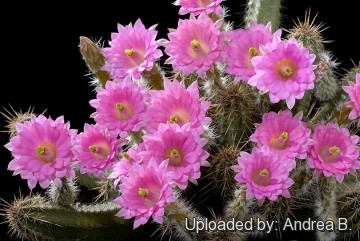 Echinocereus scheeri Photo by: Andrea B.
Echinocereus scheeri Photo by: Andrea B.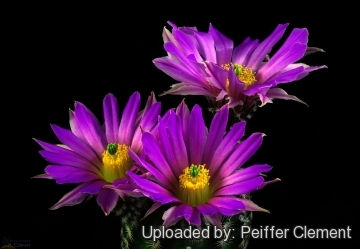 - Echinocereus schereri P 300 (Collector: Jörg and Brigitte Piltz) Rio Nazas, Durango, Mexico. Photo by: Peiffer Clement
- Echinocereus schereri P 300 (Collector: Jörg and Brigitte Piltz) Rio Nazas, Durango, Mexico. Photo by: Peiffer Clement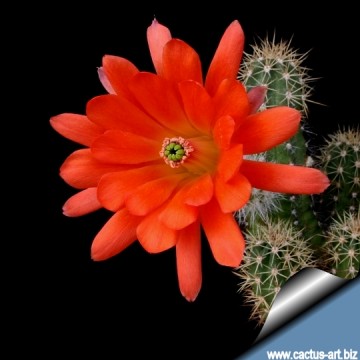 Echinocereus scheeri Photo by: Cactus Art
Echinocereus scheeri Photo by: Cactus Art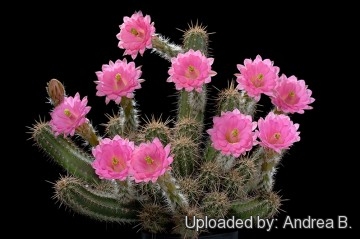 Echinocereus scheeri Photo by: Andrea B.
Echinocereus scheeri Photo by: Andrea B.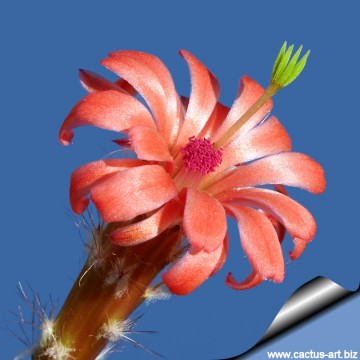 Echinocereus scheeri Photo by: Cactus Art
Echinocereus scheeri Photo by: Cactus Art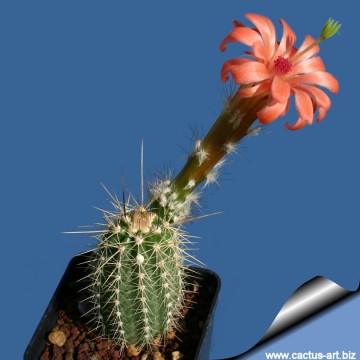 Echinocereus scheeri Photo by: Cactus Art
Echinocereus scheeri Photo by: Cactus ArtSend a photo of this plant.The gallery now contains thousands of pictures, however it is possible to do even more. We are, of course, seeking photos of species not yet shown in the gallery but not only that, we are also looking for better pictures than those already present.
Read More... Cultivation and Propagation: In culture Echinocereus scherii is without problems, easy to grow, very attractive and regularly shows its beautiful flowers, if provided with an adequate winter rest period.
Growth rate: It is a relatively rapidly growing species that will make clumps given the best conditions.
Soils: It likes very porous standard cactus mix soil.
Repotting: This plant needs plenty of space for its roots, repotting should be done every other year or when the it has outgrown its pot. Use pot with good drainage.
Watering: It is sensitive to over-watering (rot prone), and needs good drainage. Keep drier and cool in winter. In the summer it need an airy location in bright sun; keep it well watered when it's hot.
Fertilization: Feed with a high potassium fertilizer in summer.
Hardiness: In the winter light, cool, and absolutely dry conditions. Reputedly resistant to frost if kept on the dry side prior to, and during, cold weather (hardy to -7° C or less for short periods of time, USDA Zone 9 to 10). In mild climate they grow well when planted freely outside in well-drained soil.
Exposition: The plant tolerates bright situations which encourages flowering, but is likely to suffer from sun scorch or stunted growth if over exposed to direct sunlight during the hottest part of the day in summer. It may tolerate filtered sunlight or afternoon shade.
Uses: It is an excellent plant for container growing. It look fine in a cold greenhouse and frame or outdoor in a rockery.
Pests & diseases: It may be attractive to a variety of insects, but plants in good condition should be nearly pest-free, particularly if they are grown in a mineral potting-mix, with good exposure and ventilation. Nonetheless, there are several pests to watch for:
- Red spiders: Red spiders may be effectively rubbed up by watering the plants from above.
- Mealy bugs: Mealy bugs occasionally develop aerial into the new growth among the wool with disfiguring results, but the worst types develop underground on the roots and are invisible except by their effects.
- Scales: Scales are rarely a problem.
- Rot: This species is particularly easy and accommodating, seldom suffer of cryptogamic diseases. Rot it is only a minor problem with Echinocereus if the plants are watered and “aired” correctly. If they are not, fungicides won't help all that much.
Propagation: Seeds or cuttings, as it can branch from the base. To make a cutting twist off a branch and permit it to dry out a couple of weeks, lay it on the soil and insert the stem end partially into the soil. Try to keep the cutting somewhat upright so that the roots are able to grow downward.

















